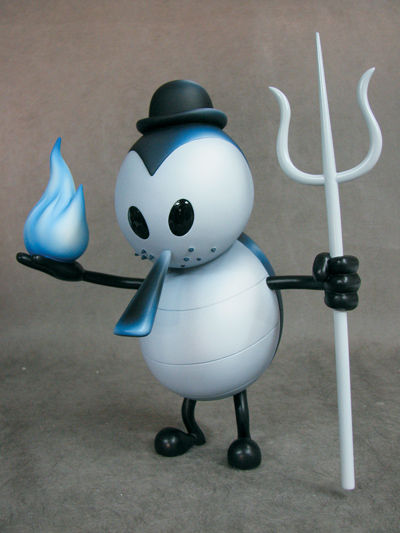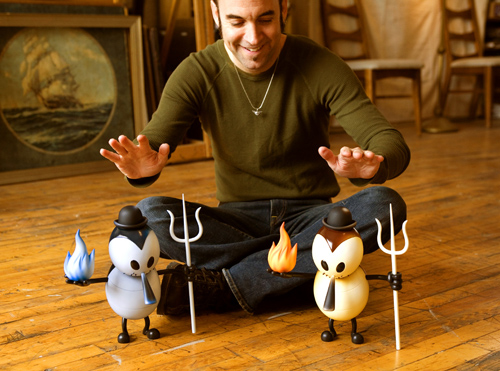 Glenn Barr's robots, creatures, and vixens live in a seedy yet swinging 1960's universe, drenched in the haze of a post-industrial hangover. From Detroit, Glenn's artwork mixes pop culture elements with pulp art and cartoons, creating paintings that are mesmerizing in both their simplicity and depth. We recently had a chance to interview Glenn, so read on and enjoy!
Glenn Barr's robots, creatures, and vixens live in a seedy yet swinging 1960's universe, drenched in the haze of a post-industrial hangover. From Detroit, Glenn's artwork mixes pop culture elements with pulp art and cartoons, creating paintings that are mesmerizing in both their simplicity and depth. We recently had a chance to interview Glenn, so read on and enjoy!Dark Horse Comics: As the trend toward limited-edition toys and figures inspired by modern artists continues to grow, how do you view these developments with regard to your own body of work? Do you see the 3-D versions of characters like Hell's Proprietor as one significant component of your overall artwork, similar to a new painting or lithograph, or as an ancillary program that is apart from the work you create entirely on your own?
Glenn Barr: I consider the toy venue to be an extension of my ideas and that delving into 3D is perhaps the logical step in widening the scope of creativity. I always try to push the limits of what I can do and not be satisfied with the status quo. As a painter it's always nice to alternate from one medium to another. Painting all the time can make you crazy. I've collected toys for years and have a great respect for good design and composition. I've been dabbling in sculpture and plaster casting for quite awhile with little success and find making a toy is the perfect outlet for what I'd like see happen for the Hell's Proprietor.
DH: Where did Hell's Proprietor come from, anyway? Can you give us any background on how it was created?
GLB: This little beetle has been popping up in drawings and paintings for years. He was initially a humorous antidote to some of my more surreal depictions of a post-apocalyptic carnival midway. He then slowly turned from barker into a managerial position relocating him in Hell. A position he felt suited his stern yet gentle nature. He sees to it that all cares are met and that everyone is comfortable . . .

DH: Where is your work displayed and sold at present? If it is mostly galleries, do these places also carry items like the vinyl figures, stationery, and journal products?
GLB: My main source of exposure comes from gallery exhibitions. I will be having a solo show in June at the Outré Gallery in Australia. I'm really looking forward to it. I've got a whole new body of work that I've been immersed in for the past couple of months. The show is entitled "No Means Yes."
With every show I try to bring in all aspects of my work including prints and books and now toys. If there is a gallery store, it usually caters to the folks who love the artist branded merch. The limited edition toys have become a big part of this. Because, well, who doesn't like toys?

DH: A lot of your imagery has a comics/cartoon sensibility, or at least some of the recurring elements do. Were comics and related pop art stuff a part of your formative years as your art developed?
GLB: Yes. I really got my chops from doing comics work and then developing my color theory from painting backgrounds in animation. Being in love with pulp art from the forties, fifties, sixties, and seventies was a large influence too. I have albums filled with book covers from those eras . . . beautiful stuff.
DH: As the worldwide flood of short-run designer toys continues unabated, do you see any kind of a "shake-out" or over-saturation looming ahead? Or, on the other hand, do you see the market for these things continuing to grow?
GLB: Well, too much of anything usually isn't a good thing. But I see the limited edition figures continuing for some time. I wish I could be more pessimistic about my optimism. I guess I'm enjoying the moment too much to care . . .
DH: Do you collect any of these things?
GLB: I do have several toys from my contemporaries. Baseman, Biskup, Woodring, Burns, Williams, Ware, Crumb, Garcia, Toki Doki, Claus, Nara, Cooper . . . Millionaire . . . etc. It's getting a little out of control I guess . . .